Sandtray Therapy
“Sandtray’s power lies in the gradual revelation to the patient through his (her) own work, accompanied by the understanding of it, which is meditated to him (her) through the therapist, of his (her) inner experience.”
— Margaret Lowenfeld, Originator of Sandtray Therapy
Sandtray Therapy for People of All Ages
Sandtray therapy is a process-oriented experience, which activates the senses, emotions, creativity, and intellect. The sandtray therapy process creates a place where expression of needs and wants is not dependent upon words. Using a container of sand and a world composed of miniatures, the creator builds a three dimensional picture, which comes from different levels of consciousness. The therapist and the builder of the world are co-explorers. Sandtray is for people of all ages, from pre-schoolers to seniors.
It is challenging to use words to describe a process that can be so powerful and evocative. As one participant at a sand tray training said, “My experience of creating my first sandtray was one of surprise-I had no idea how deeply the activity could go, with such ease”
During a sandtray session the therapist is both witness and guide, creating space for the builder to bring to awareness to what they have created. The therapist creates safety through presence and empathic curiosity.
In our current understanding of the brain and interpersonal neurobiology, the witness is the safe presence allowing the builder to create with their right hemisphere and to verbalize the experience with their left hemisphere, integrating these two ways of being. The right hemisphere is the land of implicit memory, emotional experience, sensation and body awareness, intuition, metaphor, felt autobiographical narrative and play. The right hemisphere only knows the present moment. A melody and a rhythm without words. The left is the land of language, logic, making meaning, spoken narrative, a calendar containing past, present and future. The words of the song, but without melody or rhythm . Together the song has melody, rhythm and words. The right and left hemispheres working together create a holistic experience; body and mind, working together to bringing deeper meaning to the surface.

History of Sandtray
Sandtray therapy was originally developed by Margaret Lowenfeld, a British pediatrician and psychoanalyst who lived in the first half of the last century. In her office she had miniatures, and metal trays with sand and water to occupy her child clients. They placed the miniatures in the trays and created stories. Dr. Lowenfeld developed this activity into sandtray therapy and later the World Technique. She gave her young patients credit for its genesis.
The modality was further expanded by Dora Kalff in the mid twentieth century; a Jungian psychoanalyst she studied with Margaret Lowenfeld and Karl Jung and developed Sand Play which combines Jungian therapy, symbolism and is influenced by Buddhism.
Recently the term Sand Therapy has been gaining in popularity and refers to a variety of methodologies.
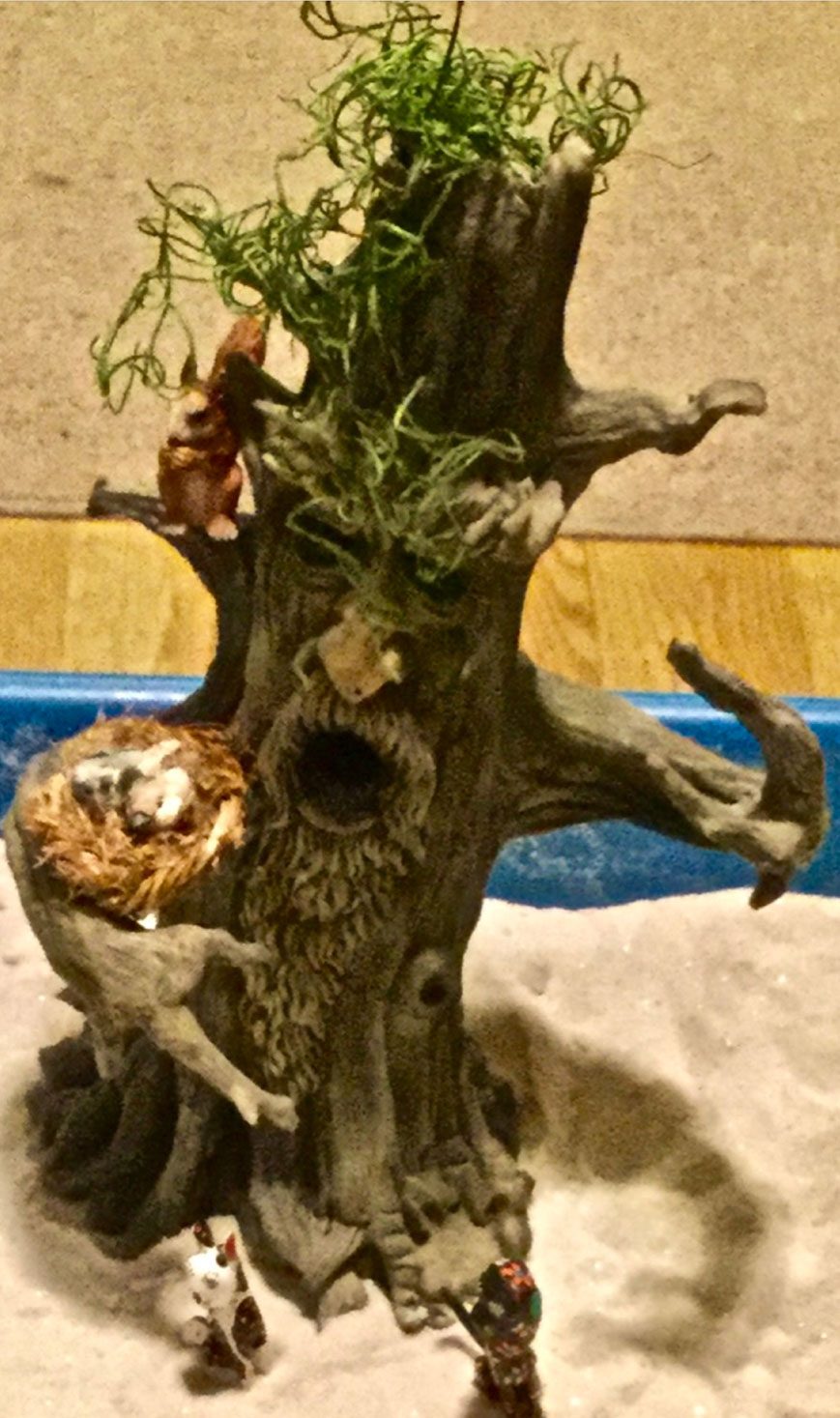
Sandtray through the Lifespan
Sandtray has a natural appeal to children who are attracted to the tactile nature of the sand and to the miniatures. For children who have been sexually or physically hurt, it is a soothing, safe and positive way to experience good touch.
Children—Ages 3 to 11
Clinical benefits
- Bypasses defenses and allows expression of difficult issues
- Expresses many opposites such as distress and coping, destruction and reconstruction
- Stays in metaphor unless child choses to connect to current life
- Releases feelings and activates inner resources.
- Body is engaged in shaping the scenes, creating and telling the story
- Soul connects to a deeply felt experience.
The sand worlds of children of different ages and developmental stages are naturally quite varied as the two examples below indicate. Unlike adult trays, they are often active sand worlds, a story with many chapters. Often the children talk as they create and may ask the therapist to become directly involved.
Sandtray of a Typical Pre-schooler
Demian enjoys his sandtray, a miniature world full of sensory play, battles, burying and uncovering, and a simple story of superheroes and villains. Sandtrays with 3 to 5 year olds may look chaotic. The trays tend to involve sensory play, building and destroying, burying and hiding and frequent battles.
Sandtray of a Typical Older Elementary Child.
In this tray, Estelle, a fifth grader, creates a story which involves hidden treasure and princesses who work together to outsmart the thieves who are attempting to steal their gold. Elementary age children tend to use the sand to make rivers, roads, islands, etc. using the tray as a whole, create thematic stories which often have conflicts. Often boys’ trays are characterized by physical battles and girls by relational issues.
Sand tray of a Teen or Adult
One way of introducing sandtray to teen and adult clients is to suggest that creating a sandtray scene is like a waking dream.
The following are often characteristic of their trays.
- Non-directive trays-created in the moment
- Directive about a particular topic
- Created in silence.
- When completed processed with therapist
- Processing connects tray to current life
- Discoveries, deeper understandings emerge
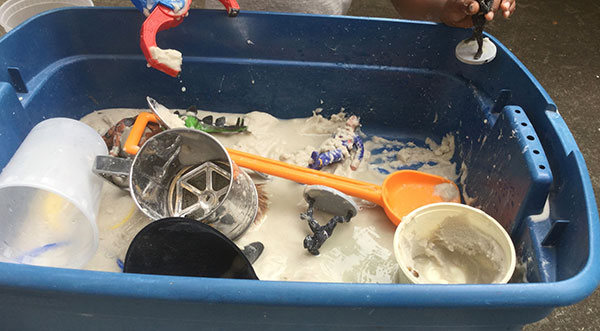
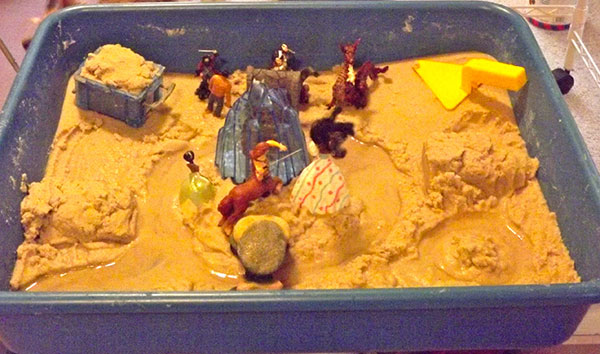
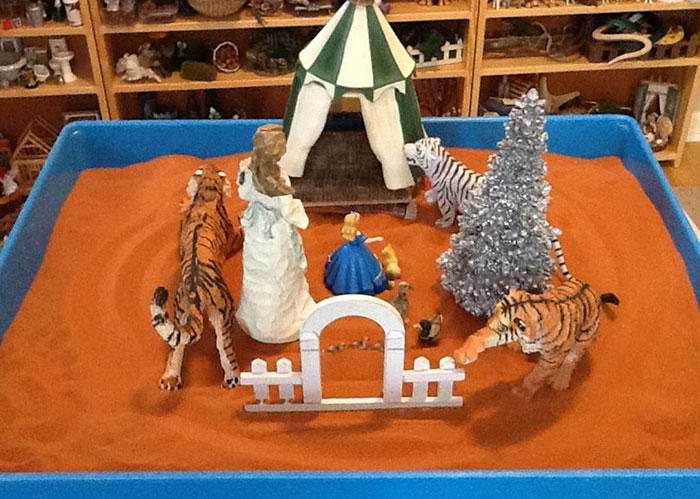
Sandtray of a Typical Pre-schooler
Demian enjoys his sandtray, a miniature world full of sensory play, battles, burying and uncovering, and a simple story of superheroes and villains. Sandtrays with 3 to 5 year olds may look chaotic. The trays tend to involve sensory play, building and destroying, burying and hiding and frequent battles.

Sandtray of a Typical Older Elementary Child.
In this tray, Estelle, a fifth grader, creates a story which involves hidden treasure and princesses who work together to outsmart the thieves who are attempting to steal their gold. Elementary age children tend to use the sand to make rivers, roads, islands, etc. using the tray as a whole, create thematic stories which often have conflicts. Often boys’ trays are characterized by physical battles and girls by relational issues.

Sand tray of a Teen or Adult
One way of introducing sandtray to teen and adult clients is to suggest that creating a sandtray scene is like a waking dream.
The following are often characteristic of their trays.
- Non-directive trays-created in the moment
- Directive about a particular topic
- Created in silence.
- When completed processed with therapist
- Processing connects tray to current life
- Discoveries, deeper understandings emerge

Other Sandtray Possibilities
Group Sandtray:
Sandtray can be done in a group with children, teens or adults. For children a group can provide social skills training-sharing the miniatures, sharing time and listening respectfully to each other. Group sandtray can be used with adults with powerful results. For example, members of a support group for people with a chronic illness created individual trays and shared their experiences. Eight people participated, simultaneously creating trays. Then taking turns, each member spoke of their life, the effects of pain and their ways of coping. The experience was described as deeply moving. Members spoke of feeling more connected to each other after the sandtray experience.
Couple Sandtray:
Couples can create worlds together or separately, depending on their issues. The sandtray can provide a safe container to examine their lives, including the issues bringing them to therapy and possible solutions. One couple came to therapy because they could not agree on having a child. The directive was first to build a tray together in silence, and then for each woman to describe what the tray meant to them while the other one listened. The partner who did not want a child, realized that her concerns, came from her family of origin and were not relevant to their current situation. A couple tray can be used to explore both current dynamics and issues as well as those more related to their families of origin
Family Sandtray:
There are many ways sandtray therapy can be used with families. Structured storytelling can be utilized in which each member choses figures and as a group they create a story together.
Family members can build trays together or separately on a particular topic. Trays can be useful for enmeshed parent-child dyads. In that situation, each builds a separate tray and therapist helps with the processing so that the parent and the child can see the other as individuals with their own hopes, wishes and dreams.
Sandtray for Supervision:
Sandtrays can be used as a powerful tool in presenting cases, especially when the situations are challenging. They can also be used in a small group as a reflective sandtray process, in which 1 group member presents a case, creates a tray and simultaneously the other members create individual trays reflecting on the presenter’s case.
Sandtray and Culture
The idea of using sandtray to explore culture is an exciting development in Growth through Play Therapy’s use of this modality. Our communities are increasingly diverse and there is a need for therapists to become more comfortable exploring culture. An important step in becoming competent with this sensitive area is to first explore our own culture. Our clients also benefit from having an arena to explore the meaning of culture in their lives. The advantage of using sandtray is that it creates a safe space to explore culture, a space that encourages an entrée into this topic sidestepping defensiveness and encouraging dialogue.
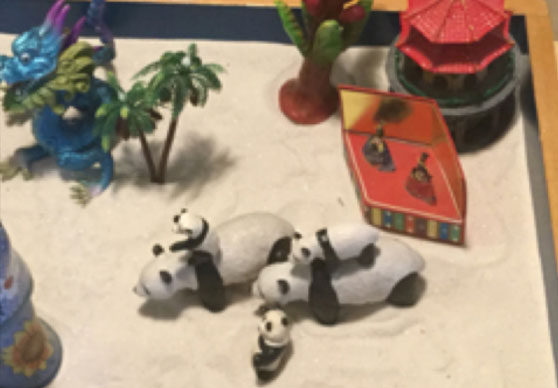
Personal Addendum
I fully appreciates all that I has gained from the opportunity to explore so many worlds with my clients and with other professionals. I am especially grateful to Violet Oaklander who introduced me to this magical world, and to those I studied with, especially Gisella De Domenico, Dottie Higgins Klein and Bonnie Badenoch.
Enhance your play therapy skills!
Karen Pernet LCSW, RPT-S
Oakland, CA 94602
510-923-0520
karen@growththroughplaytherapy.com
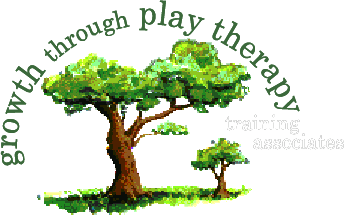
I would be glad to hear from you and to share information about my services: psychotherapy, general supervision for pre-licensed therapist, specialized supervision for therapists working becoming Registered Play Therapists, consultations for experienced therapists and trainings in play therapy and sandtray therapy.
